Here is a selection of research papers, articles, books and reports about the work of the Nansen Center for Peace and Dialogue. The list is not extensive and will gradually be expanded. Feel free to send us an e-mail with your questions or comments. post@peace.no

Unconditional Spaces in Dialogue Processes. A Case Study on Interethnic Dialogue at the Nansen Center for Peace and Dialogue in Norway
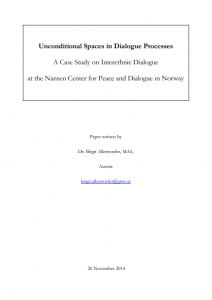 Within this paper, I deepen the understanding of Unconditional Spaces in the context of interethnic dialogue processes. The case study at the Nansen Center for Peace and Dialogue in Lillehammer, Norway, hence provides inspiring insights into the process design of reconciliation efforts on the Western Balkan. While taking part in a one – week dialogue seminar with a group of teachers from Mostar, Bosnia and Herzegovina, I discovered elements of unconditionality in diverse process settings. I identified four main Unconditional Spaces within the seminar structure and perceived the whole dialogue process in Lillehammer as a omprehensive unconditional experience.
Within this paper, I deepen the understanding of Unconditional Spaces in the context of interethnic dialogue processes. The case study at the Nansen Center for Peace and Dialogue in Lillehammer, Norway, hence provides inspiring insights into the process design of reconciliation efforts on the Western Balkan. While taking part in a one – week dialogue seminar with a group of teachers from Mostar, Bosnia and Herzegovina, I discovered elements of unconditionality in diverse process settings. I identified four main Unconditional Spaces within the seminar structure and perceived the whole dialogue process in Lillehammer as a omprehensive unconditional experience.
Throughout this paper, I therefore describe the core qualities, benefits and limitations of these phenomena in peace building. In order to convey a clear picture of Unconditional Spaces in dialogue processes, I call the four categories “ice breaker”, referring to the Olympic ski jump, “new horizon”, talking about an open school, “uniting bond”, pointing at a family dinner, and “laughing smile”, comprising experiences at a fun park. These four seminar components, among others, compliment the core dialogue sessions and support the facilitation effort of creating a protected group spaces. They provide simultaneous experiences of a “safe shelter” and “spirit of freedom” and promote relaxation, emotional openness and visibility. The latter are crucial for sustainable dialogue and reconciliation work, as they constitute the foundation for the ability to relate to oneself and others.
Through participatory observation and personal interviews, I consequently convey diverse perspectives onto the process and from within the seminar group. I highlight the strengths of the Nansen approach and open up the room for further discussions on Unconditional Spaces in peace building initiatives. As unconditionality embraces a variety of forms, I whole – heartedly invite the audience to adapt Unconditional Spaces according to their respective needs.
Case study By Dr. Birgit Allerstorfer
34 pages
Direct download link (PDF, 435 KB)

Dialogue as a tool in peacebuilding. Theoretical and empirical perspectives
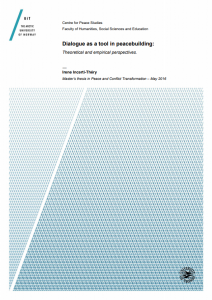 Dialogue is important as humans are in constant communication with one another. As the world currently witnesses violent conflicts on a daily basis, how we respond to conflicting views in communication is an infinitely important matter for human coexistence. We have the possibility to respond with fear, hatred and violence or with open-mindedness, acceptance and understanding. I ask; Is dialogue a peacebuilding tool whose potential has not been exploited? This thesis will discuss dialogue as one form of communication and as a tool in peacebuilding. I take a critical view of the use of dialogue to reach other goals than understanding. I have chosen to collect data from experts on dialogue in Norway and from the United Nations to research the topic of dialogue as a tool in peacebuilding. The research project’s relevance for peace studies is its contribution to literature on dialogue, specifically dialogue in relation to peacebuilding. Further, the study is relevant for peace studies as it addresses how the United Nations work with intercultural and inter-religious dialogue in peacebuilding.
Dialogue is important as humans are in constant communication with one another. As the world currently witnesses violent conflicts on a daily basis, how we respond to conflicting views in communication is an infinitely important matter for human coexistence. We have the possibility to respond with fear, hatred and violence or with open-mindedness, acceptance and understanding. I ask; Is dialogue a peacebuilding tool whose potential has not been exploited? This thesis will discuss dialogue as one form of communication and as a tool in peacebuilding. I take a critical view of the use of dialogue to reach other goals than understanding. I have chosen to collect data from experts on dialogue in Norway and from the United Nations to research the topic of dialogue as a tool in peacebuilding. The research project’s relevance for peace studies is its contribution to literature on dialogue, specifically dialogue in relation to peacebuilding. Further, the study is relevant for peace studies as it addresses how the United Nations work with intercultural and inter-religious dialogue in peacebuilding.
Master’s thesis by Irene Incerti-Théry
104 pages
UiT The Arctic University of Norway (2016)
Available through Munin Open Research Archive

Definition, necessity, and Nansen: Efficacy of dialogue in peacebuilding
 In international conflict resolution the term dialogue is used frequently while lacking specificity. When examined in practice, dialogue is revealed as a specific, efficacious method for conflict management and peacebuilding. This article defines dialogue specifically through description of eight characteristics: coexistence; movement; encountering the “other”; assumption; creativity and flexibility; sharing; holistic; and multigenerational. In defining dialogue, a parameter is drawn and a method clarified. The case of Macedonia and the Nansen Dialogue Network (NDN) is drawn upon to illustrate these traits and the success of the method in long‐term conflict management and peacebuilding. NDN has used its dialogic approach in Macedonia, leading to integrated schooling. As integrated schooling has continued success with NDN as an ongoing dialogue facilitator, as of 2011 the Macedonia government is considering it as an educational model. As evidence of further success, this dialogue work has led to continued funding as well as peace‐related awards and nominations to NDN. Understanding the nature and success of dialogue as practiced is an essential, though often overlooked, aspect of international relations work.
In international conflict resolution the term dialogue is used frequently while lacking specificity. When examined in practice, dialogue is revealed as a specific, efficacious method for conflict management and peacebuilding. This article defines dialogue specifically through description of eight characteristics: coexistence; movement; encountering the “other”; assumption; creativity and flexibility; sharing; holistic; and multigenerational. In defining dialogue, a parameter is drawn and a method clarified. The case of Macedonia and the Nansen Dialogue Network (NDN) is drawn upon to illustrate these traits and the success of the method in long‐term conflict management and peacebuilding. NDN has used its dialogic approach in Macedonia, leading to integrated schooling. As integrated schooling has continued success with NDN as an ongoing dialogue facilitator, as of 2011 the Macedonia government is considering it as an educational model. As evidence of further success, this dialogue work has led to continued funding as well as peace‐related awards and nominations to NDN. Understanding the nature and success of dialogue as practiced is an essential, though often overlooked, aspect of international relations work.
By Amanda E. Feller and Kelly K. Ryan
30 pages
Published in Conflict Resolution Quarterly, volume 29, issue 4 (2012)
Available through Leibniz Information Centre for Science and Technology University Library

Prio/Nansen Case Study: The Balkan Dialogue Project
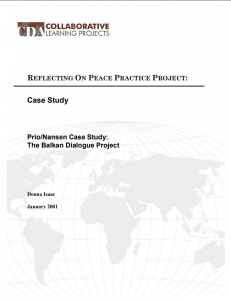 This case study will examine the Balkan Dialogue Project that is actually two integrated projects. The initial project of Democracy, Human Rights, and Peaceful Conflict Resolution began in 1995 with training at the Nansen Academy in Lillehammer, Norway. The Nansen Dialogue project is a pedagogical concept and served as the starting point for the later Balkan Dialogue Project. The Balkan Dialogue Project began in 1999. It is an activity that evolved from the educational premise of the earlier project. In this paper, the two projects are viewed as one integrated process and the earlier distinction thus has become irrelevant. The Balkan Dialogue Project is discussed from its earliest history, then the case study examines the roles of the cooperating partners that are both governmental and nongovernmental agencies and finally the participants’ views of the process. From this perspective, the case study looks at how the participants are taking the dialogue process back to their respective regions and the impact of this local dialogue building.
This case study will examine the Balkan Dialogue Project that is actually two integrated projects. The initial project of Democracy, Human Rights, and Peaceful Conflict Resolution began in 1995 with training at the Nansen Academy in Lillehammer, Norway. The Nansen Dialogue project is a pedagogical concept and served as the starting point for the later Balkan Dialogue Project. The Balkan Dialogue Project began in 1999. It is an activity that evolved from the educational premise of the earlier project. In this paper, the two projects are viewed as one integrated process and the earlier distinction thus has become irrelevant. The Balkan Dialogue Project is discussed from its earliest history, then the case study examines the roles of the cooperating partners that are both governmental and nongovernmental agencies and finally the participants’ views of the process. From this perspective, the case study looks at how the participants are taking the dialogue process back to their respective regions and the impact of this local dialogue building.
By Donna Isaac
23 pages
Publisher: Collaborative Learning Projects (2001)
Available through CDA

Interethnic Dialogue and Cooperation for Integrated Education in BiH – The Practice and Experiences of the Nansen Dialogue Center Sarajevo
 Since the end of the war in the 1990s Bosnia and Herzegovina (BiH) has been considered a deeply ethnically divided society, where ethnicity determines almost all aspects of life: cultural, social, political, and economical. This chapter reflects on the experience of the Nansen Dialogue Center in Sarajevo (NDC Sarajevo) and its mission to promote interethnic dialogue and to create interethnic initiatives among ethnically divided communities in BiH. In particular, the roles of parents, teachers, students, principals, and politicians in the initiatives for integrated education are examined.
Since the end of the war in the 1990s Bosnia and Herzegovina (BiH) has been considered a deeply ethnically divided society, where ethnicity determines almost all aspects of life: cultural, social, political, and economical. This chapter reflects on the experience of the Nansen Dialogue Center in Sarajevo (NDC Sarajevo) and its mission to promote interethnic dialogue and to create interethnic initiatives among ethnically divided communities in BiH. In particular, the roles of parents, teachers, students, principals, and politicians in the initiatives for integrated education are examined.
By Ljuljjeta Goranci-Brkic
9 pages
pp 59-68 of Integrated Education in Conflicted Societies
Publisher: Palgrave Macmillan, New York (2013)
Available through Springer Link

Dialogue helps you understand others and yourself : An ethnographic study on the significance of dialogue
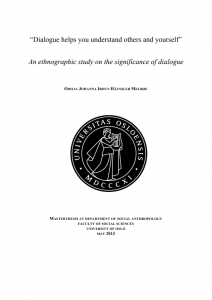 Through this empirical study on the significance of dialogue, this thesis aims to fill a knowledge gap in dialogical anthropology, contributing with a processual and relational perspective on how to understand dialogue. I have conducted seven months of fieldwork among participants and employees at Nansen Center for Peace and Dialogue, in Lillehammer, Norway, and have taken part in seminars where dialogue is significant as concept and practice. The interlocutors in this study have background from Afghanistan, Iraqi Kurdistan, Bosnia-Herzegovina, Serbia, Croatia, Macedonia, Kosovo, United States, some living in these respective countries and some in Norway. Most of the interlocutors have experiences with conflict, and come to the seminars to learn about dialogue techniques, meet people from different sides in a conflict, and to build cooperation between participants, both in diaspora groups in Norway and in their country of origin.
Through this empirical study on the significance of dialogue, this thesis aims to fill a knowledge gap in dialogical anthropology, contributing with a processual and relational perspective on how to understand dialogue. I have conducted seven months of fieldwork among participants and employees at Nansen Center for Peace and Dialogue, in Lillehammer, Norway, and have taken part in seminars where dialogue is significant as concept and practice. The interlocutors in this study have background from Afghanistan, Iraqi Kurdistan, Bosnia-Herzegovina, Serbia, Croatia, Macedonia, Kosovo, United States, some living in these respective countries and some in Norway. Most of the interlocutors have experiences with conflict, and come to the seminars to learn about dialogue techniques, meet people from different sides in a conflict, and to build cooperation between participants, both in diaspora groups in Norway and in their country of origin.
This thesis brings forward how knowledge acquired at seminars is understood and applied among interlocutors, and how participating in seminars is experienced. Taking part in seminars is by participants expressed as connecting and becoming like a family. Furthermore, similarities and differences emerged in identification processes among participants during seminars, for instance in different ways of practising Islam. I argue that the way interlocutors approach practising dialogue can be looked upon as a meta-perspective on communication. I argue that these ways of talking create internal jargons of understanding between participants, that I call `dialoging´. Among interlocutors in this study, change on a personal level has been described like becoming a new person, or having a personal transformation. Moreover, several of the participants want to use what they learn, for instance starting dialogue initiatives in their countries, which underlines a social relevance of the seminars I have studied.
Masters thesis by Odilia Johanna Irdun Häussler Melbøe
128 pages
University of Oslo (2013)
Available through UiO dUo vitenarkiv

“Two Schools Under One Roof” The divided education in Bosnia and Herzgovina
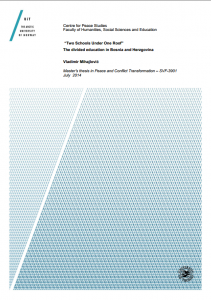 Bosnia and Herzegovina is a multi-ethnic society with three ethnic groups (Bosniaks, Serbs and Croats) comprising a vast majority of the population. The dissolution of Yugoslavia found these three ethnic groups at war with one another, a war that lasted 4 years and claimed around 100 000 lives. The war ended with the peace agreement in Dayton, 1995 that officially established two territorial entities within the country, the Serb Republic and the Federation of Bosnia and Herzegovina (with Bosniaks and Croats comprising most of the population). As opposed to the period before the war, the country was completely split along ethnic lines. The educational system was also divided with different content and curriculums for each ethnic group in what is known as the national group of subjects. History in particular is taught differently to students of different ethnic groups. My goals is to showcase these differences and discuss their possible impact on the young citizens of Bosnia and Herzegovina, establish whether hey perpetuate the existing rifts and tensions or contributes to a more tolerant view of other ethnic groups. I am also intrigued by cases of having students of different ethnic groups sharing the same school premises, yet attending all classes separately. Such cases came to be known as ‘Two Schools under the same roof’. Symbolically, ‘the same roof’ can also refer to the state of Bosnia and Herzegovina and its numerous students of different background learning different truths about their country and historical events that shaped its narrative.
Bosnia and Herzegovina is a multi-ethnic society with three ethnic groups (Bosniaks, Serbs and Croats) comprising a vast majority of the population. The dissolution of Yugoslavia found these three ethnic groups at war with one another, a war that lasted 4 years and claimed around 100 000 lives. The war ended with the peace agreement in Dayton, 1995 that officially established two territorial entities within the country, the Serb Republic and the Federation of Bosnia and Herzegovina (with Bosniaks and Croats comprising most of the population). As opposed to the period before the war, the country was completely split along ethnic lines. The educational system was also divided with different content and curriculums for each ethnic group in what is known as the national group of subjects. History in particular is taught differently to students of different ethnic groups. My goals is to showcase these differences and discuss their possible impact on the young citizens of Bosnia and Herzegovina, establish whether hey perpetuate the existing rifts and tensions or contributes to a more tolerant view of other ethnic groups. I am also intrigued by cases of having students of different ethnic groups sharing the same school premises, yet attending all classes separately. Such cases came to be known as ‘Two Schools under the same roof’. Symbolically, ‘the same roof’ can also refer to the state of Bosnia and Herzegovina and its numerous students of different background learning different truths about their country and historical events that shaped its narrative.
Masters thesis by Vladimir Mihajlovic
98 pages
UiT The Arctic University of Norway (2014)
Available through Munin Open Research Archive

The Silence of Inaction – A qualitative study of the impact that Nansen dialogue seminars have had on ethnic relations in Stolac
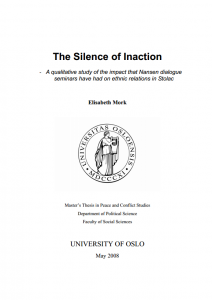 The primary aim of this thesis is to investigate if the dialogue seminars organised by the Nansen Dialogue Centre (NDC) in Mostar have had a perceptible impact on ethnic relations locally in Stolac, at the level of practices and/or representations – and if so, in which ways. The main method used for generating empirical data was qualitative analysis of interviews with four teachers who work at the ethnically segregated Stolac High School. The empirical data from the interviews with the teachers were compared with data from interviews with two participants from Srebenica. The findings indicate that the dialogue seminars have created a limited sphere for inter-ethnic interaction for the teachers in Stolac. In the seminars they were able to share common goals and needs, and work on joint problems regarding Stolac High School. However, the seminars do not seem to have had a significant impact at the level of practices. There is a relative absence of newly initiated inter-ethnic social relationships involving the participants from Stolac taking part in the dialogue seminars. The teachers have not had much further contact with one another without help from the NDC, even though they all argue that this contact is highly appreciated and needed. Some interpretations for the teachers’ apparent reluctance to initiate contact with “the other” participants are addressed in this thesis.
The primary aim of this thesis is to investigate if the dialogue seminars organised by the Nansen Dialogue Centre (NDC) in Mostar have had a perceptible impact on ethnic relations locally in Stolac, at the level of practices and/or representations – and if so, in which ways. The main method used for generating empirical data was qualitative analysis of interviews with four teachers who work at the ethnically segregated Stolac High School. The empirical data from the interviews with the teachers were compared with data from interviews with two participants from Srebenica. The findings indicate that the dialogue seminars have created a limited sphere for inter-ethnic interaction for the teachers in Stolac. In the seminars they were able to share common goals and needs, and work on joint problems regarding Stolac High School. However, the seminars do not seem to have had a significant impact at the level of practices. There is a relative absence of newly initiated inter-ethnic social relationships involving the participants from Stolac taking part in the dialogue seminars. The teachers have not had much further contact with one another without help from the NDC, even though they all argue that this contact is highly appreciated and needed. Some interpretations for the teachers’ apparent reluctance to initiate contact with “the other” participants are addressed in this thesis.
Masters thesis by Elisabeth Mork
97 pages
University of Oslo (2008)
Available through UiO Duo Vitenarkiv

Evaluation of Norwegian Development Cooperation with the Western Balkans
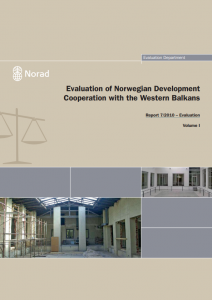 This report presents the findings of an evaluation of a large portion of Norwegian development cooperation that has not previously been systematically evaluated. During the period 1991-2008 the Norwegian aid to the Western Balkans amounted to about ten billion Norwegian kroner. The decision by our Department to carry out this evaluation was based partly on the Norwegian Government’s criterion for evaluation of importance and size, partly on the criterion of uniqueness, in the sense that the object of the evaluation has been development aid to European countries.
This report presents the findings of an evaluation of a large portion of Norwegian development cooperation that has not previously been systematically evaluated. During the period 1991-2008 the Norwegian aid to the Western Balkans amounted to about ten billion Norwegian kroner. The decision by our Department to carry out this evaluation was based partly on the Norwegian Government’s criterion for evaluation of importance and size, partly on the criterion of uniqueness, in the sense that the object of the evaluation has been development aid to European countries.
Overall, the conclusions are quite encouraging. The aid has met the needs on the ground and the programmes have generally been effective. While it may be difficult to judge the longer term effect of many of the undertakings, others are assessed to have had quite positive impacts.
This does not mean that there have been no weaknesses. The report raises a number of issues, some explicitly, others more implicitly in its many observations and findings. Some of these issues are well-known from other evaluations, others more thought-provoking.
164 pages
Publisher: Norad
Report 7/2010 – Evaluation
Available through Norad

Education at a standstill: how the consociational school of thought has perpetuated ethnic conflict in post-war Bosnia
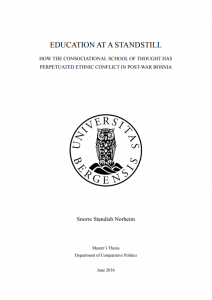 This study set out to explore why the consociational prescription to have cultural autonomy in education contributes to perpetuating ethnic conflict instead of conflict resolving, in post-war societies like Bosnia and Herzegovina. The prescription is to recognise and strengthen the major ethnic groups through decentralisation of decision-making in education. The study analyses a fragmented and politicised educational system, and its consequences for inter-ethnic relations, which are analysed and presented as manifestations of exclusivist, educational protectionism. The single-case study on consociational post-war Bosnia and Herzegovina builds on interview data from a three-week-long fieldwork in Mostar and Sarajevo, in January 2016.
This study set out to explore why the consociational prescription to have cultural autonomy in education contributes to perpetuating ethnic conflict instead of conflict resolving, in post-war societies like Bosnia and Herzegovina. The prescription is to recognise and strengthen the major ethnic groups through decentralisation of decision-making in education. The study analyses a fragmented and politicised educational system, and its consequences for inter-ethnic relations, which are analysed and presented as manifestations of exclusivist, educational protectionism. The single-case study on consociational post-war Bosnia and Herzegovina builds on interview data from a three-week-long fieldwork in Mostar and Sarajevo, in January 2016.
Master thesis by Snorre Standish Norheim
143 pages
University of Bergen (2016)
Available through Bergen Open Research Library

“This is Kosova”. Segregation and dialogue through education in Kosovo
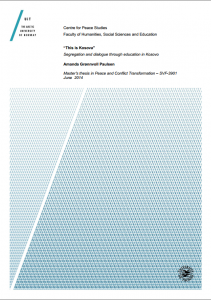 The Balkan region has been a place for conflict ant intergroup bias several times the last 100 years. After Tito’s death in 1980, Yugoslavia started to crumble from within. The economy was in ruin, the question of ethnicity, which had been hidden away during Titos rule, surfaced and wars broke out because of this. Some of the republics and autonomous states in Yugoslavia demanded to be independent. Kosovo was one autonomous state that wanted to be independent. After years of riots and minor conflicts a war broke out in Kosovo in 1999. NATO intervened in the war between Kosovo and Serbia to stop ethnic cleansing. After the war there has been a division between the ethnic groups. The majority of Kosovo-Serbs are living in the north, in a city called Mitrovica. The segregation between the ethnic groups have been so extreme that most of the young people who are growing up now, have never seen or met a person from the other ethnic group. When a society is segregated, and the division between the people is so profound, it could easily turn into a new conflict. There is no communication, so no one really knows what is going on with the other group. To change that I believe one can do extracurricular activities where mixed education I central. By using Allport’s theory of contact and Gaertner’s three conditions for intergroup contact I will look into how and/or if mixed education can help promote long lasting peace in Kosovo.
The Balkan region has been a place for conflict ant intergroup bias several times the last 100 years. After Tito’s death in 1980, Yugoslavia started to crumble from within. The economy was in ruin, the question of ethnicity, which had been hidden away during Titos rule, surfaced and wars broke out because of this. Some of the republics and autonomous states in Yugoslavia demanded to be independent. Kosovo was one autonomous state that wanted to be independent. After years of riots and minor conflicts a war broke out in Kosovo in 1999. NATO intervened in the war between Kosovo and Serbia to stop ethnic cleansing. After the war there has been a division between the ethnic groups. The majority of Kosovo-Serbs are living in the north, in a city called Mitrovica. The segregation between the ethnic groups have been so extreme that most of the young people who are growing up now, have never seen or met a person from the other ethnic group. When a society is segregated, and the division between the people is so profound, it could easily turn into a new conflict. There is no communication, so no one really knows what is going on with the other group. To change that I believe one can do extracurricular activities where mixed education I central. By using Allport’s theory of contact and Gaertner’s three conditions for intergroup contact I will look into how and/or if mixed education can help promote long lasting peace in Kosovo.
Masters thesis by Amanda Grønnvoll Paulsen
49 pages
The Arctic University of Norway (2014)
Available through Munin Open Research Archive

Can Dialogue Make a Difference? The Experience of the Nansen Dialogue Network
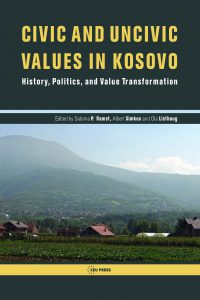 The main argument in this chapter is that the focus of international peacebuilding, which has been to build strong institutions to secure the functionality of the state, is not sufficient as it is when it neglects dialogue and reconciliation between the citizens of the same state. The wars in the Western Balkans in the 1990s left many communities ethnically segregated. In a segregated society, people grow up with reduced knowledge and experience of each other. This lack of knowledge and understanding weakens representative democracy in these societies. In the case of Kosovo the generations of Serbs and Albanians coming of age are not learning each other’s language or enough about each other’s cultural and spiritual heritage. This will reduce the functionality of and reduce the effect of democracy in the new state.
The main argument in this chapter is that the focus of international peacebuilding, which has been to build strong institutions to secure the functionality of the state, is not sufficient as it is when it neglects dialogue and reconciliation between the citizens of the same state. The wars in the Western Balkans in the 1990s left many communities ethnically segregated. In a segregated society, people grow up with reduced knowledge and experience of each other. This lack of knowledge and understanding weakens representative democracy in these societies. In the case of Kosovo the generations of Serbs and Albanians coming of age are not learning each other’s language or enough about each other’s cultural and spiritual heritage. This will reduce the functionality of and reduce the effect of democracy in the new state.
By Steinar Bryn
Pp. 365-394 of Civic and uncivic values in Kosovo: History, politics, and value transformation
Central European University Press (2015)
Available through Project Muse

Intergroup social contact through peace education: The nansen model for integrated education
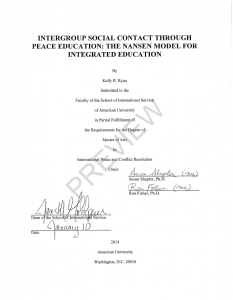 Both peace education and social contact theory enjoy substantial places in conflict resolution literature. However, more research is needed to understand the intersection of these two approaches to peacebuilding. This study examines the relationship between peace education and social contact theory within a post-conflict context, specifically in the Republic of Macedonia. The Nansen Model for Integrated Education (NMIE) provides a useful case study to examine this relationship. The findings build on existing literature, suggest both theoretical and practical implications for peacebuilding, and recommend future avenues of research to better expound on the relationship between peace education and social contact theory.
Both peace education and social contact theory enjoy substantial places in conflict resolution literature. However, more research is needed to understand the intersection of these two approaches to peacebuilding. This study examines the relationship between peace education and social contact theory within a post-conflict context, specifically in the Republic of Macedonia. The Nansen Model for Integrated Education (NMIE) provides a useful case study to examine this relationship. The findings build on existing literature, suggest both theoretical and practical implications for peacebuilding, and recommend future avenues of research to better expound on the relationship between peace education and social contact theory.
Masters thesis by Kelly R. Ryan
136 pages
American University (2014)
Available through Pro Quest

Dialogue with Diaspora
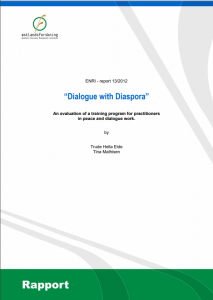 The report presents an evaluation of the project “Dialogue with the Diaspora” undertaken by The Nansen Center for Peace and Dialogue (NCPD), March 2012. The project consisted of a training course for 13 practitioners involved in peace and reconciliation work in Afghanistan, Iraqi Kurdistan, Bosnia HercegovinaHercegovina and people from the Diaspora living in Norway. The course was organised around the themes of identity and communication, dialogue, mediation, conflict solving, and the role of the Diaspora in peace building. Drawing on the accounts and feedback given by the participants, it is reasonable to conclude that the broad aims of this course have been achieved. The interviewees reported greater trust, self-confidence and more courage. Other important outcomes are better understanding of dialogue as an essential tool in for dealing with conflicts, and increased openness to learning about the background of the conflict situation. Still, there remains room for improvement in the area of developing of practice in the course. Likewise, it seems that there should be some changes in relation to strengthening the long-term cooperation and network among the participants and the NCPD
The report presents an evaluation of the project “Dialogue with the Diaspora” undertaken by The Nansen Center for Peace and Dialogue (NCPD), March 2012. The project consisted of a training course for 13 practitioners involved in peace and reconciliation work in Afghanistan, Iraqi Kurdistan, Bosnia HercegovinaHercegovina and people from the Diaspora living in Norway. The course was organised around the themes of identity and communication, dialogue, mediation, conflict solving, and the role of the Diaspora in peace building. Drawing on the accounts and feedback given by the participants, it is reasonable to conclude that the broad aims of this course have been achieved. The interviewees reported greater trust, self-confidence and more courage. Other important outcomes are better understanding of dialogue as an essential tool in for dealing with conflicts, and increased openness to learning about the background of the conflict situation. Still, there remains room for improvement in the area of developing of practice in the course. Likewise, it seems that there should be some changes in relation to strengthening the long-term cooperation and network among the participants and the NCPD
By Trude Hella Eide and Tina Mathisen
371 pages
Publisher: Østlandsforskning (2012)
Available through Østlandsforskning

Keep on Talking! Review of the Nansen Dialogue Network in the Western Balkans
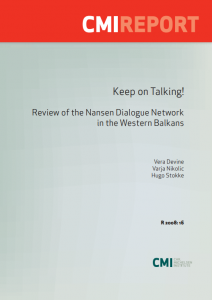 The review considered whether NDN activities have contributed to improved ethnic relations and to sustainable peace and reconciliation in the Western Balkans by promoting inter-ethnic dialogue. The review found that NDN has clearly contributed to better ethnic relations by influencing the attitudes and actions of strategic individuals at the community level, but also at the institutional level by offering opportunities for interethnic cooperation beyond the space for dialogue. The review found it harder to draw definite conclusions about overall contributions towards sustainable peace as NDN activities are subject to the volatility of the larger political environment, over which NDN has very little influence and has few resources to deal with. It should be borne in mind that the entire aid effort in the Western Balkans has not succeeded conclusively in changing opinion on the ground and any potential or actual NDN impact would have to be seen against this general state of affairs. By concentrating on local interventions, however, NDN has succeeded in gaining trust in specific communities and the review recommends continuing this type of activities in the future, drawing on the joint advantage of inside knowledge and long-term engagement.
The review considered whether NDN activities have contributed to improved ethnic relations and to sustainable peace and reconciliation in the Western Balkans by promoting inter-ethnic dialogue. The review found that NDN has clearly contributed to better ethnic relations by influencing the attitudes and actions of strategic individuals at the community level, but also at the institutional level by offering opportunities for interethnic cooperation beyond the space for dialogue. The review found it harder to draw definite conclusions about overall contributions towards sustainable peace as NDN activities are subject to the volatility of the larger political environment, over which NDN has very little influence and has few resources to deal with. It should be borne in mind that the entire aid effort in the Western Balkans has not succeeded conclusively in changing opinion on the ground and any potential or actual NDN impact would have to be seen against this general state of affairs. By concentrating on local interventions, however, NDN has succeeded in gaining trust in specific communities and the review recommends continuing this type of activities in the future, drawing on the joint advantage of inside knowledge and long-term engagement.
By Vera Devine, Varja Nikolic, Hugo Stokke
82 Pages
Publisher: Chr. Michelsen Institute (CMI Report R 2008: 16)
Available via Chr. Michelsen Institute

Language, education and conflicts in the Balkans: policies, resolutions, prospects
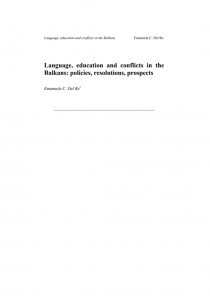 The issue of the languages and education in the Balkans is heated, despite the fact that in the last twenty years many epochal events have occurred that have radically changed the scenario in each country and in the region. The dissolution of former-Yugoslavia, the agreements of Dayton and Ohrid, the Stability Pact, the process of EU enlargement have had a significant impact on the Balkan populations also from the cultural and educational point of view. The Balkan languages are on one hand reacquiring their dignity, uniqueness and personality, on the other hand they are becoming a way of asserting the identity of an ethnic group over another, in an eternal game of prevaricators and prevaricated that perpetuates a latent tension and endangers stability. The importance of the legislative and constitutional measures that protect minorities, as well as the constant confrontation with the international community – in particular the EU – with its shared values and approaches, ensures that there is no escalation of tensions and conflicts. Nevertheless, the educational system is still the emblem of identity policies based on nationalism. History textbooks are an interesting example. The prospects are related to mutual recognition, overcoming the painful past. This essay explores all these aspects and takes the reader on a analytical journey in this intricate issue, providing a complex view of the situation and of the conflict resolutions strategies, with a vision for the future.
The issue of the languages and education in the Balkans is heated, despite the fact that in the last twenty years many epochal events have occurred that have radically changed the scenario in each country and in the region. The dissolution of former-Yugoslavia, the agreements of Dayton and Ohrid, the Stability Pact, the process of EU enlargement have had a significant impact on the Balkan populations also from the cultural and educational point of view. The Balkan languages are on one hand reacquiring their dignity, uniqueness and personality, on the other hand they are becoming a way of asserting the identity of an ethnic group over another, in an eternal game of prevaricators and prevaricated that perpetuates a latent tension and endangers stability. The importance of the legislative and constitutional measures that protect minorities, as well as the constant confrontation with the international community – in particular the EU – with its shared values and approaches, ensures that there is no escalation of tensions and conflicts. Nevertheless, the educational system is still the emblem of identity policies based on nationalism. History textbooks are an interesting example. The prospects are related to mutual recognition, overcoming the painful past. This essay explores all these aspects and takes the reader on a analytical journey in this intricate issue, providing a complex view of the situation and of the conflict resolutions strategies, with a vision for the future.
Article by Emanuela, C. Del Re
28 pages
Pp. 189-217 in ITALIAN JOURNAL OF SOCIOLOGY OF EDUCATION, 5(3), 2013
Publisher: Padova University Press (2013)
Available through Padova University Press

Lessons learned from dialogue work between Serbs and Albanians in Serbia and Kosovo
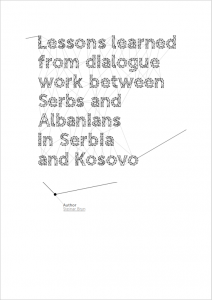 In 1995, the project “Democracy, Human Rights and Peaceful Conflict Resolution” began at the Nansen Academy in Lillehammer, Norway. As Lillehammer hosted the Olympics in 1994, it developed a strong solidarity with Sarajevo, at that time under siege. As a small academy with a dormitory, at the Nansen Academy we realised that we could contribute by inviting groups of people from the Western Balkans to come for three months to analyse the breakup of Yugoslavia and to identify whether it was possible to rebuild trust, communication and cooperation.
In 1995, the project “Democracy, Human Rights and Peaceful Conflict Resolution” began at the Nansen Academy in Lillehammer, Norway. As Lillehammer hosted the Olympics in 1994, it developed a strong solidarity with Sarajevo, at that time under siege. As a small academy with a dormitory, at the Nansen Academy we realised that we could contribute by inviting groups of people from the Western Balkans to come for three months to analyse the breakup of Yugoslavia and to identify whether it was possible to rebuild trust, communication and cooperation.
This article describes some of the specifics of the Nansen Dialogue, which made both sides feel secure enough to share their stories. The article also sheds light on how the process increased the feelings of equality and respect among the participants.
By Steinar Bryn
28 pages
Pp. 58 – 87 in Creating Spaces for Dialogue – A Role for Civil Society
Publisher: The Global Partnership for the Prevention of Armed Conflict (2015)
Available through GPPAC (Download link, PDF 1,6 MB)

Nansen Dialogue: Contact and Reconciliation in Former Yugoslavia
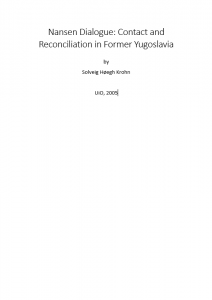 The research question posed in this thesis is the following: which effect do the Nansen dialogue seminars have on interpersonal reconciliation, and what is the possible effect on reconciliation of the postconflict society in former Yugoslavia?
The research question posed in this thesis is the following: which effect do the Nansen dialogue seminars have on interpersonal reconciliation, and what is the possible effect on reconciliation of the postconflict society in former Yugoslavia?
The Balkan Dialogue Project is an initiative of the Nansen Academy in Lillehammer, Norway, and is intended to contribute to interethnic reconciliation and peacebuilding in former Yugoslavia.
Masters thesis by Solveig Høegh Krohn
UiO (2005)

Evaluation of peacebuilding projects: Case study of Bosnia and Herzegovina
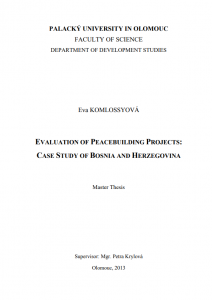 This Masters thesis seeks to outline the framework for evaluating peacebuilding projects. It identifies the distinguishing features of the evaluations of peacebuilding interventions and criteria used for such evaluations. The framework is then used to evaluate a peacebuilding project implemented in the post-conflict environment of Bosnia and Herzegovina by the local nongovernmental organisation, Nansen Dialogue Centre Sarajevo. The purpose of the evaluation is to assess the impact of the project on the stakeholders involved in the process, and on the broader post-conflict situation in Bosnia and Herzegovina. The thesis concludes with lessons learnt, and describes the best practices that could be used in similar contexts in the future.
This Masters thesis seeks to outline the framework for evaluating peacebuilding projects. It identifies the distinguishing features of the evaluations of peacebuilding interventions and criteria used for such evaluations. The framework is then used to evaluate a peacebuilding project implemented in the post-conflict environment of Bosnia and Herzegovina by the local nongovernmental organisation, Nansen Dialogue Centre Sarajevo. The purpose of the evaluation is to assess the impact of the project on the stakeholders involved in the process, and on the broader post-conflict situation in Bosnia and Herzegovina. The thesis concludes with lessons learnt, and describes the best practices that could be used in similar contexts in the future.
By Eva Komlossyová
86 pages
PALACKÝ UNIVERSITY IN OLOMOUC (2013)
Available through theses.cz

Successful Local Peacebuilding in Macedonia
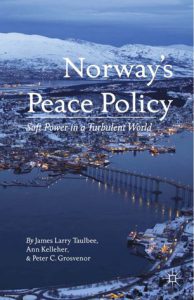 Norway has a comprehensive approach in carrying out its peace policy. Norwegians not only engage in peacemaking, but they also continue their commitment by supporting post-agreement peacebuilding. Often, this takes the form of local development projects that engage people from polarised groups in deeply divided societies. Two schools in Macedonia provide an example of Norway’s support for intercommunity peacebuilding. The Nansen Primary and Secondary Schools are located in Macedonia’s Jegunovce Municipality—an area involved in the 2001 civil war. The schools enable local Macedonian and Albanian children to experience an integrated education—highly noteworthy because it flourishes amid segregated schooling for Macedonian- and Albanian-speaking children.
Norway has a comprehensive approach in carrying out its peace policy. Norwegians not only engage in peacemaking, but they also continue their commitment by supporting post-agreement peacebuilding. Often, this takes the form of local development projects that engage people from polarised groups in deeply divided societies. Two schools in Macedonia provide an example of Norway’s support for intercommunity peacebuilding. The Nansen Primary and Secondary Schools are located in Macedonia’s Jegunovce Municipality—an area involved in the 2001 civil war. The schools enable local Macedonian and Albanian children to experience an integrated education—highly noteworthy because it flourishes amid segregated schooling for Macedonian- and Albanian-speaking children.
By James Larry Taulbee, Ann Kelleher and Peter C. Grosvenor
22 pages
Chapter 6 of Norway’s Peace Policy pp 139-161
Publisher: Palgrave Macmillan, New York (2014)
Available through Palgrave Macmillan
Portions of this chapter were published previously in Ann Kelleher and Kelly Ryan, “Successful Local Peace building in Macedonia: Sustained Dialogue in Practice,” Peace Research — The Canadian Journal of Peace and Conflict Studies, 44, 1 (2012): 63–94.

Peacebuilding and culture in Bosnia and Herzegovina – Resistance or emancipation?
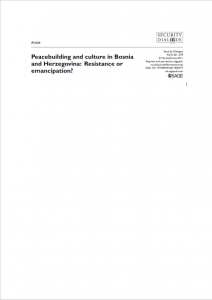 This article investigates problems and pitfalls involved in the EU’s peacebuilding activities in Bosnia and Herzegovina. It claims that by romanticizing civil society and selectively reinforcing existing power structures, the European Union has failed to give society a stake in the peace that is being created in that country. Against this background, the article goes on to argue that local responses and forms of resistance have begun to emerge in Bosnia and Herzegovina, challenging the EU’s peacebuilding mission to move towards a more contextualised engagement with local society. Rather than focusing exclusively on the EU’s formal institutional mechanisms, a more contextualised approach would seek to include a wide variety of local agencies and create a space in which Bosnian society might develop alternative versions of peace that relate to people’s everyday lives. The main challenge for the EU, the article concludes, is to take the diversity of Bosnia’s local voices seriously in efforts to promote a hybrid, sustainable peace.
This article investigates problems and pitfalls involved in the EU’s peacebuilding activities in Bosnia and Herzegovina. It claims that by romanticizing civil society and selectively reinforcing existing power structures, the European Union has failed to give society a stake in the peace that is being created in that country. Against this background, the article goes on to argue that local responses and forms of resistance have begun to emerge in Bosnia and Herzegovina, challenging the EU’s peacebuilding mission to move towards a more contextualised engagement with local society. Rather than focusing exclusively on the EU’s formal institutional mechanisms, a more contextualised approach would seek to include a wide variety of local agencies and create a space in which Bosnian society might develop alternative versions of peace that relate to people’s everyday lives. The main challenge for the EU, the article concludes, is to take the diversity of Bosnia’s local voices seriously in efforts to promote a hybrid, sustainable peace.
By Stefanie Kappler and Oliver Richmond
18 Pages
Publisher: Sagepub (2011)
Available through Sage Journals

People Building Peace II: Successful Stories Of Civil Society
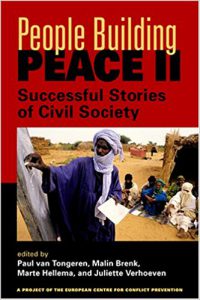 Individuals can make a difference working for peace worldwide. That is the message of People Building Peace II, an inspiring collection of stories of how “”ordinary”” men and women have played a crucial part in conflict prevention and peacebuilding. Thematic chapters, illustrated with compelling case studies, present new trends in the role of civil society in conflict transformation. The cases reflect the variety of activities initiated and sustained by a broad range of actors, including women’s groups, youth groups, and faith-based organisations. Such topics as reconciliation, dialogue, networking, and traditional methods of conflict resolution are among the topics thoroughly explored, as are the successful initiatives of lesser-known NGOs. The resulting rich tapestry, an outcome of the Global Partnership for the Prevention of Armed Conflict, is an invaluable compendium of best practices and lessons learned, and at the same time a stirring call to action.
Individuals can make a difference working for peace worldwide. That is the message of People Building Peace II, an inspiring collection of stories of how “”ordinary”” men and women have played a crucial part in conflict prevention and peacebuilding. Thematic chapters, illustrated with compelling case studies, present new trends in the role of civil society in conflict transformation. The cases reflect the variety of activities initiated and sustained by a broad range of actors, including women’s groups, youth groups, and faith-based organisations. Such topics as reconciliation, dialogue, networking, and traditional methods of conflict resolution are among the topics thoroughly explored, as are the successful initiatives of lesser-known NGOs. The resulting rich tapestry, an outcome of the Global Partnership for the Prevention of Armed Conflict, is an invaluable compendium of best practices and lessons learned, and at the same time a stirring call to action.
By Paul Van Tongeren (Editor), Malin Brenk (Editor), Marte Hellema (Editor), Juliette Verhoeven (Editor)
697 pages
Publisher: Lynne Rienner Pub ( 2005)
Available through Amazon